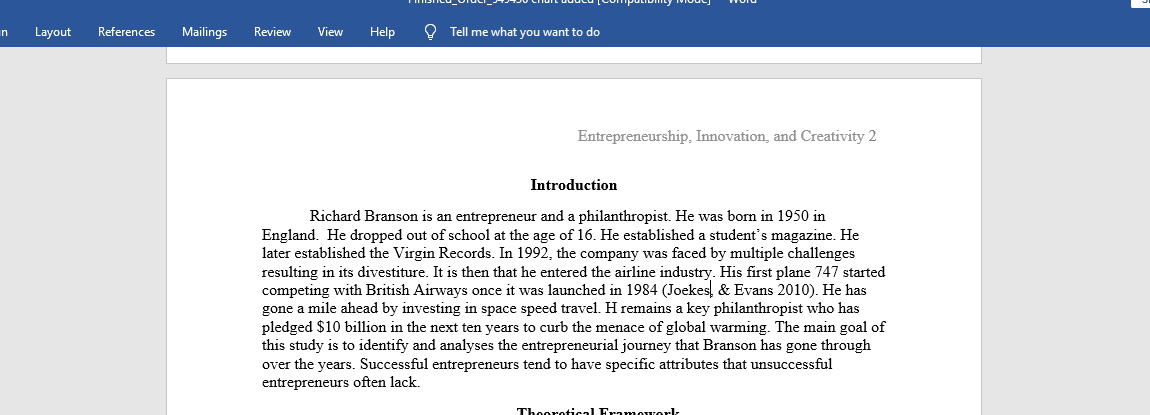The module is Entrepreneurship, innovation and creativity. The assignment requires you to research an entrepreneur and apply appropriate academic literature to understand why and how they were successful. I can select any entrepreneur.
Order description:
Task 1a. Interview or conduct desk top research on an ‘entrepreneur’.
This could be a social or business enterprise and need not be well known. Select the entrepreneur about whom you would like to learn the most. Furthermore their primary goal should have been to create a new venture, hence not someone who was in music, arts, sports who then decided to start a venture based on their fame. Select and adapt the questions appropriate for your case study. You should introduce your entrepreneur at the onset in the assignment, but keep this very brief, details can be placed in the appendices, timeline or in text box. The aim is to progress from here and analyse their journey in the subsequent sections and not describe their journey, also key points of his life story that make him succeed I have to show in graph..
Task 1b. Select appropriate frameworks.
E.g. You may start with one core framework , such as those listed below and then augment it with additional literature through highlighting its limitations, or you may take a more integrated approach:
Timmons FORT – Available in Canvas. Timmons JA and Spinelli S (2009) New Venture Creation: Entrepreneurship for the 21st Century, Chapter 3, pgs. 101 – 117, McGraw Hill 8th Edition.
Burns Start Up Influences – Available in Canvas and Core text
Bolton & Thomsons FACET – Thompson, J. L. (2004). The facets of the entrepreneur: identifying entrepreneurial potential. Management Decision, 42(1/2), 243-258. https://www.emeraldinsight.
Moore – Bygrave Model of Entrepreneurial Process in Bygrave & Zacharakis (2004), The Portable MBA in Entrepreneurship. Wiley & sons. Sarasvathy on Effectuation.
The first task is to briefly introduce to demonstrate that you understand the model(s) before you apply it in more detail which is the key requirement(One framework i have to show the one which the most suitable for my entrepreneur.)
Task 1.c Having selected your approach i.e. using a core model or a more integrated approach. The essence of the assignment is to apply the theoretical framework(s) to your chosen entrepreneur(s) and critically examine to what extent the model(s) explain the journey of your chosen entrepreneur. If you use a core framework then augment this with what other factors if any were important for your entrepreneur’s success e.g. beyond what Timmons or Burns discuss.
This is the essence of the assignment and the key here is to be critical and try to demonstrate your understanding from a holistic perspective i.e. which includes person and process (entrepreneur, entrepreneurship and innovation). E.g. if you utilise FORT then there are limitations around Timmons discussion on Opportunity, whereby Sarasvathy’s effectuation perspective may provide better explanation. Similarly, if Burns was your core it is good at providing the ‘influences’ to start up but not the dynamics, where Timmons and Sarasvathy provide stronger insights.
Task 1d Based on your response to the above, what do you conclude about successfully launching and growing a new venture from a venture creation and personal perspective? This is in effect your conclusion based on what you have learnt through researching the entrepreneur and reading the academic literature about the process of ‘entrepreneurship and innovation’ from a venture creation perspective. Alongside your personal learning from the module and the assignment. Whoever you choose, focus on analysing the story not telling the story. Use the literature to demonstrate a holistic and academically critical understanding of how the entrepreneur evolved their idea from conception to implementation and why they were successful in starting and growing the venture.
The following points may help you as you unravel the reasons for success.
1)The entrepreneur’s background (e.g. family history, childhood experiences, education, work experience).
2)The entrepreneurial journey (e.g. the first idea/challenge undertaken).
3)The opportunity (innovation), which made the entrepreneur successful, how it arose, what influenced and motivated the entrepreneur to identify and pursue this opportunity. What the entrepreneur did (identify specific activities) to turn the opportunity into a business (e.g. marshal resources, build a team, conduct research).
4)Business Strategies and decisions e.g. in relation to marketing, financing, operations. What major challenges did the entrepreneur encounter during the creation of this business? How were those problems dealt with?
5)The Entrepreneur’s Network. Who did the entrepreneur use for help and guidance during the start-up of this business? Describe the social context of the entrepreneur.
6)The role of luck, personality, culture.
The aim is to develop a thorough and practical understanding of what is involved in starting and growing a successful venture from a lead entrepreneur’s perspective. You are reminded to make use of examples from your chosen entrepreneur and draw upon wider reading of the entrepreneurial literature, in your response.
Higher marks will be awarded for:
Understanding & Analysis – identification and critical analysis of key issues, quality of reasoning, clear conclusions.
Evidence of further reading – beyond lecture notes and core text.
Use of relevant theories, frameworks and terminology.
Creativity – in evaluation and presentation
Structure, Style & Presentation of work – clear organisation, logical flow with appropriate use of tables, diagrams and appropriately referenced.
Answer preview for The module is Entrepreneurship, innovation and creativity.
Access the full answer containing 2372 words by clicking the below purchase button

